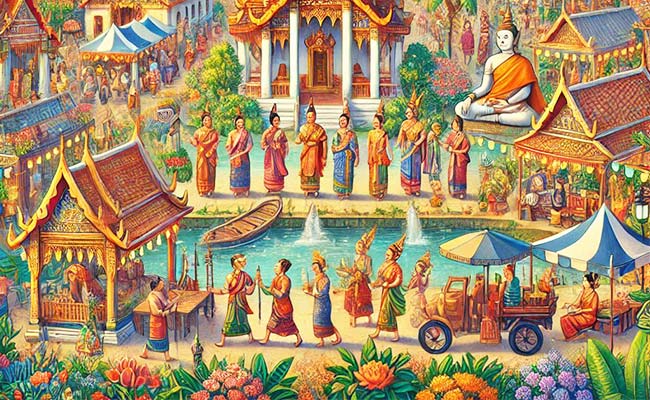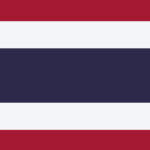Many foreigners frequent Thailand, coming back year after year. Some even settle down, calling the Land of Smiles home. Yet, despite this deep connection, many know little about how modern-day Thailand came to be. While the country's temples, festivals, and royal traditions are part of everyday life, its history remains an enigma to many.
Let's face it: few people want to wade through dense history books or long-winded accounts of ancient battles and shifting dynasties. That’s why I’ve crafted this concise guide, to provide a quick yet engaging overview of Thailand’s journey from its earliest settlements to the dynamic nation we see today. Whether you’re a traveler, expat, or simply curious, this guide will give you a solid understanding of the rich history underpinning modern Thailand.

Early Settlements and the Origins of the Tai People
Thailand’s history begins long before kingdoms were established. Archaeological evidence shows that prehistoric settlements existed as early as 2000 BCE. The Ban Chiang site in northeast Thailand, a UNESCO World Heritage Site, reveals evidence of advanced metalworking and agricultural practices, marking it as one of the earliest centers of metallurgy in Southeast Asia. Ban Chiang provides critical insights into early Bronze Age cultures and their innovations.
The first people to inhabit the region were likely Austroasiatic and Austronesian groups. These early communities cultivated rice, domesticated animals, and developed early trade networks. Over time, they were influenced by Indian and Chinese cultures, introducing Hinduism, Buddhism, and complex social structures. The Austronesians, in particular, played a significant role in maritime and coastal developments.
The Tai people, ancestors of modern Thais, began migrating southward from southern China around the 8th–10th centuries. Their movement was likely driven by pressure from expanding Chinese empires. By the 13th century, the Tai had established dominance in the region, laying the foundation for the kingdoms that followed.
Historians widely agree that the Tai people trace their origins to the Bai-Yue (or “Hundred Yue”) tribes of southern China and northern Vietnam. These tribes, known for their agricultural skills, bronze technology, and complex societies, began migrating southward under duress from Chinese imperial expansion. The origins of the Thai people, however, remain a subject of ongoing scholarly debate.
For a deeper dive into this topic, read my post on Thai Origins here.
Early Kingdoms (Pre-13th Century)
The period before the 13th century in what is now Thailand was marked by the emergence of several significant kingdoms that shaped the region's cultural and economic landscape. Among the most notable were the Dvaravati and Srivijaya civilizations, which laid crucial foundations for the later development of Thai culture and society.
Dvaravati Civilization
The Dvaravati civilization, flourishing from the 6th to the 11th centuries CE, was centered in the Chao Phraya River basin. The Mon-speaking people, who formed the backbone of this kingdom, played a pivotal role in introducing and spreading Theravada Buddhism in the region. Archaeological evidence, such as votive tablets, stone inscriptions, and wheel-shaped stupas, reflects the profound influence of Indian art, religion, and politics on Dvaravati culture.
This civilization was not a centralized kingdom but rather a collection of loosely connected city-states, such as Nakhon Pathom and Lopburi. Its strategic location facilitated trade with India, China, and other Southeast Asian regions, making it a hub for cultural exchange and economic activity. The Dvaravati's decline in the 11th century is often attributed to the expansion of the Khmer Empire, which absorbed much of its territory.
Srivijaya Influence
During the same period, the Srivijaya Empire, based on the island of Sumatra, extended its influence into the southern part of present-day Thailand, particularly the Malay Peninsula. Srivijaya was a dominant maritime power, controlling key trade routes in the Strait of Malacca and the South China Sea. Its influence on southern Thailand was both economic and cultural, as the empire facilitated the spread of Mahayana Buddhism and promoted the exchange of goods and ideas.
Srivijaya’s control over the Malay Peninsula introduced a distinct cultural and religious layer to the region, with Hindu-Buddhist practices blending with local traditions. Evidence of Srivijaya's influence in southern Thailand can still be seen in ancient temple ruins, inscriptions, and artifacts found in areas like Nakhon Si Thammarat and Chaiya.
Other Influences
Apart from the Dvaravati and Srivijaya, other smaller polities and tribes contributed to the region’s cultural tapestry. These included the Funan Kingdom, an early Southeast Asian polity that influenced trade and politics, and the Khmer Empire, which expanded into the region, bringing sophisticated architectural and cultural practices.
Transition to Tai Dominance
The emergence of the Tai people began to shape the sociopolitical dynamics of the region by the late 1st millennium CE. These migrations set the stage for the eventual rise of the Sukhothai Kingdom in the 13th century, marking the beginning of what is often considered the historical era of Thailand.
The Sukhothai Kingdom (1238–1438): The Birth of Thai Identity
The Sukhothai Kingdom emerged in 1238 when two Tai leaders, Pho Khun Bang Klang Hao and Pho Khun Pha Muang, led a revolt against the Khmer Empire. They established an independent state with Sukhothai as its capital. Sukhothai is celebrated for its golden age of art, architecture, and governance under King Ramkhamhaeng. It was during this time that the Thai alphabet was developed, though some scholars debate the authenticity of inscriptions attributing this to him. Theravada Buddhism was established as the dominant religion.
The Ayutthaya Kingdom (1351–1767): A Global Trade Hub
By the late 14th century, the Ayutthaya Kingdom, founded by King Uthong, rose to prominence, eclipsing Sukhothai and absorbing it into its expanding territory. Its location near major rivers facilitated trade with China, India, Persia, and later European nations such as Portugal and France. Diplomatic missions to European powers in the 17th century further enhanced Ayutthaya’s international reputation.
Ayutthaya's centralized bureaucracy, modeled on the Mandala system, allowed it to control vast territories. This governance structure balanced central authority with local autonomy, ensuring stability and growth.
The Fall of Ayutthaya and the Thonburi Period (1767–1782)
Ayutthaya's success made it a target for neighboring powers. Burmese forces invaded multiple times, culminating in the devastating attack on Ayutthaya in 1767. The city was destroyed, its treasures looted, and its people scattered, leading to its collapse.
In its wake, General Taksin rallied forces and established the Thonburi Kingdom – with his capital near modern-day Bangkok – briefly uniting the Thai lands.
Taksin’s reign was marked by military campaigns and efforts to reunify the fragmented kingdom. However, his leadership style and mental state led to dissatisfaction among nobles. In 1782, General Chao Phraya Chakri overthrew Taksin and executed him, founding the Chakri Dynasty.
The Chakri Dynasty and Modernization (1782–1932)
In 1782, General Chao Phraya Chakri founded the Chakri Dynasty, which continues to this day.
King Rama I, the first Chakri monarch, moved the capital to Bangkok, establishing it as a center of trade, culture, and politics. Successive kings, particularly Rama IV (Mongkut) and Rama V (Chulalongkorn), embraced modernization to counter Western imperialism. They implemented reforms in education, infrastructure, and governance while maintaining Thailand’s sovereignty. Notably, Thailand signed the Treaty of Friendship and Commerce (1833) with the United States, marking its early participation in global diplomacy.
Remarkably, Thailand remained the only Southeast Asian nation never colonized by Western powers, thanks to skillful diplomacy and strategic modernization efforts like the abolition of slavery and the construction of railroads.
Despite these reforms, the absolute monarchy ended in 1932 after a bloodless coup. The transition to a constitutional monarchy marked the beginning of Thailand’s modern political era.
The End of Absolute Monarchy and the Path to Democracy (1932–1976)
In 1932, a bloodless coup ended absolute monarchy, transitioning Thailand to a constitutional monarchy. Political instability followed, with alternating periods of military rule and fragile democracies. During World War II, Thailand’s alliance with Japan was partly strategic, allowing it to reclaim lost territories while maintaining a degree of autonomy.
Post-war, Thailand aligned with the United States, becoming a key ally during the Cold War. The nation experienced rapid economic growth but faced social and political unrest, including student uprisings in the 1970s.
Recent History and Modern Day (1976–Present)
Since the late 20th century, Thailand has seen a complex interplay of democracy and military intervention. The Asian financial crisis of 1997 hit the country hard but led to economic reforms. Politically, Thailand has oscillated between elected governments and military coups, with the most recent coup occurring in 2014.
The nation continues to grapple with political divisions, particularly between urban elites and rural populations, as well as questions about the role of the monarchy. Despite these challenges, Thailand remains a cultural and economic leader in Southeast Asia, attracting millions of tourists each year.
In Summary
From prehistoric settlements and and kingdoms to a modern constitutional monarchy, Thailand’s history is a testament to resilience and adaptability. The Thai people’s ability to navigate challenges – from foreign invasions to modern political upheavals – reflects a unique blend of cultural pride and pragmatic diplomacy. As Thailand continues to evolve, it remains a fascinating intersection of ancient traditions and modern ambitions.
———-
Did I miss something important here? Let me know if the comments section below.
Last Updated on



Reggie says
Jan 08, 2025 at 12:24 am
Paul Hastilow says
Dec 22, 2024 at 9:58 am
TheThailandLife says
Dec 23, 2024 at 3:54 am